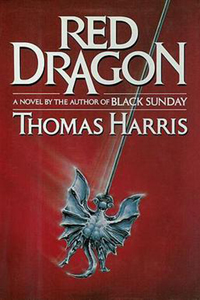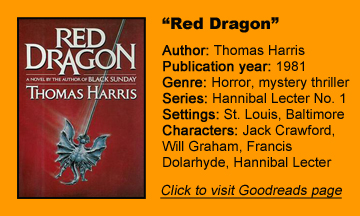To mark the 40th anniversary of author Thomas Harris’ invention of Hannibal Lecter and the 30th anniversary of “The Silence of the Lambs” – the only horror film to win Best Picture – we’re looking back at the four books and five films of the Hannibal Lecter series over nine Frightening Fridays. First up is the “Red Dragon” novel (1981):
Will Graham’s story
“Red Dragon” is the first of the “Hannibal” quadrilogy, but it reads like Harris – in his second novel overall — has stumbled upon Hannibal Lecter accidentally. Here, the future star of movies, a TV series and modern memes is a supporting character who barely has anything to do with the case of the titular Dragon, Francis Dolarhyde.
FBI profiler Will Graham had captured the now-imprisoned Hannibal in a previous case and he consults him from his mental-ward cell here only briefly.
“Red Dragon” is not quite hardboiled – I’d call it medium-boiled – in the way it chronicles Graham’s tackling of what are initially called the Tooth Fairy murders because Dolarhyde bites his murder victims.
This is an easy page-by-page read, sparked by earthy dialog and occasionally shaken up by POV shifts for the sake of needed perspective. One would never guess that writing comes hard to Harris.
Graham flies from FBI HQ in D.C. to the murder sites in Atlanta and Birmingham, plus Chicago, Detroit, St. Louis and other points. The way Graham misses his wife Molly, his stepson Willy and their Florida Keys home is not merely for flavor.
Harris knows what he’s talking about as he shows how Will’s desire for the simple pleasures of life rubs against his compulsion to catch the serial killer. Harris, a former newspaperman, also deliciously writes tabloid reporter Freddy Lounds’ pursuit of the story.
A strong procedural
Another strength is the procedures, from the way Graham gets a feel for the Leeds family (the first victims of Dolarhyde) by studying filmstrips and their home and possessions, to the way various investigators – including Graham’s FBI handler Jack Crawford – use forensics to gather clues.
1981 was before the era of mass surveillance – even before the era of connected computer systems, as a Datafax plays a role at one point – yet proven tactics and skilled people are enough to do the job.
One comes away from “Red Dragon” respecting the professionalism of these folks, not a feeling we get too much in the real world today.
Packed with characters
But amid all the procedural and tactical elements, “Red Dragon” is a story of people. Dolarhyde is a great villain. He starts off being terrifying because he’s crazy in a fascinating way, doing things such as propping up the dead family members in a scene while he fondles the woman’s corpse. Investigators can deduce that much, and we as readers are also privy to his filmstrip collection.
About halfway through the novel, Harris goes into Francis’ upbringing, and the child abuse is such that it makes perfect sense that he turned out this way. He has a harelip, and so is made fun of by his few childhood acquaintances. Even more disturbing, Francis has no loving parental figure, and his grandmother – who runs a nursing home out of her large house — is abusive in creative ways.
This novel is packed with characters; the previous owner of the paperback I bought wrote down a dramatis personae on a bookmark, and I don’t blame them. We don’t need to keep every investigator in our head, yet they have personality and verve when on stage.
Those we spend more time with get fully fleshed out. I learned a lot about the daily lives and pet peeves of blind people via Reba, a coworker of Dolarhyde’s who becomes his girlfriend.
Hannibal is here to provide the initial comment that Graham is the same as him, the only difference being their actions: Will hasn’t given in to his inner compulsion to kill.
Influence on Mulder?
Graham’s behavioral psychology monograph about a killer in a previous case is famous in the FBI just as Fox Mulder’s would be in “The X-Files,” which is famously influenced by the film version of “Silence of the Lambs.” I wonder if Graham was a starting template for Mulder. At any rate, they go off in different directions, Graham’s being much darker.
We could figure out the core similarities between Graham and Lecter even without Hannibal’s commentary. But Lecter delivers further good insights in his brief appearances, including his view that society is nutty for not killing him or for treating him well, but instead choosing the middle ground where he’s caged and punished in petty ways such as the removal of his book collection.
“We live in a primitive time, neither savage nor wise. Half-measures are the curse of it,” Lecter opines in the final chapter.
Is there something about sociopathy that allows for keener, cleaner insight into societal behavior? Harris suggests there is (at least in the case of this one sociopath), so our desire to hear more from Hannibal parallels Will’s.
And maybe the author’s, as Harris gradually writes more about Hannibal in subsequent books. Like Will, we feel dirty for wanting to learn from Lecter, and that’s the foundation for this series and the films and TV series – a solid narrative foundation, yet an endlessly creepy-crawly one.
Detailed writing
Even when Hannibal isn’t on hand to illuminate things, Harris’ writing style pulls off the trick of giving us the details we need to intimately understand Graham, Dolarhyde and Reba despite coming from an omniscient, unbiased (and, as I say, medium-boiled) perspective. That style also allows for the finale to be surprising.
“Red Dragon” is all about how smart both the heroes and villain are, yet I was still happily caught off guard by Dolarhyde’s final bit of deception.
This is an easy page-by-page read, with Harris as our expert teacher about investigative procedure, forensics and behavioral psychology. I was an eager student, but in the end, Harris remains smarter than me.



